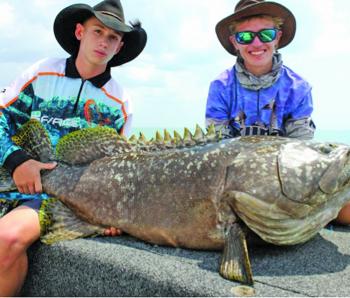The Gulf of Carpentaria is a place where everyone can catch a fish. Everywhere holds fish. It’s a place where the fishing can be absolutely insane. Nonetheless, there are times when even this ocean paradise can shut down. When this happens, catching a fish is difficult and new tactics need to be invented for success.
Barra are one of the most difficult fish to understand in the whole ocean. A single drop in temperature or barometer, or even a slight rise or drop in tide or light levels, can be the difference between a donut session or a crazy series of explosions and jumping chrome. In the dirtier river waters, barra are often more willing to take hardbodied lures, such as minnows and hard vibes.
On the clean sandy beaches of Cape York, we sight fish a lot of barra, salmon and other pelagic and estuary fish varieties. While queenies and trevally are willing to take just about anything, the other species of fish can be very spooky and difficult to catch. In these circumstances, where the water is clean and clear and the only shelter for the fish schools to hide in is the odd oyster covered rock, the loud rattle of a minnow or aggressive action of a diver repels them. Once a barra or salmon is spooked on the flats, the chances of it even thinking about eating again are very low.
Even the tiniest of minnows have no effect. What is it that is making these fish so difficult to catch? Taking a closer look at the bait that the fish were feeding on is the trick to success here. In the rivers, a barra will take just about anything from prawns, crabs and even decent-sized mullet. On the flats, they were feeding on tiny hardiheads no bigger than 2.5-3”.
We matched the size and colour of the baitfish, but we hadn’t matched the action. Unlike mullet or large prawns that flick and twitch quite aggressively, these tiny hardiheads paddled along under the surface ever so delicately, creating no ripples or bow waves. The answer was small unweighted soft plastics that created no aggressive vibrations and, just like the hardyheads, crept slowly under the surface. This was the key. We caught dozens of small barra using the subtler plastics.
We returned a few days later with the same plastics and only landed a couple of barra. We took a closer look and barra were feeding on mullet of 4-6”. We tried out a slightly larger size plastic with the same effect as the last trip. On this particular day, the colours that stood out were deep red and black. On the last trip, the stand out colour was silver or blue. This situation shows that at times when the fish are being difficult to catch, the subtle and diverse soft plastics can make all the difference.
The beauty of fishing soft plastics or soft vibes is the range of the depths and the actions that can be used. They are not only for shallow water situations, but also for fishing deep reefs where many species such as golden snapper, giant trevally, mackerel, tuna and even the famous coral trout are quite easy captures. I recently went out on a fishing trip with Dad’s mates Scotty Gorman and Evan Ikin, where we found a massive school of fish. We dropped 9” scented soft plastics into the school and hooked-up immediately.
They ended up being all large black jew over the 1m mark. One of the best sport and eating fish, black jew can be very hard to convince to bite, even when they are in large numbers. Jigs, deep divers, hard vibes and even baits such as live mullet or dead prawns seem to have no effect. Without a doubt, soft plastics are the best imitation for targeting fish in tricky situations.
On top of this, soft plastics can bring you some unexpected, rarely seen and awesome catches. I took my mate Axel out a while back and we were chasing golden snapper or cobia around some shallow reef. I was using a 10” soft plastic when all of a sudden it took off. After a few long runs, the surprisingly heavy fish slowly started to come up. I first called it for a GT, then for a big cobia or maybe a foul-hooked shark or ray.
Dad knew what it was and called it. It was a big Queensland grouper around 110-120lb! After a quick photo, this monster was released and powered back to the depths. We finished up the day with a couple of little golden snapper, stripeys and a colourful little black spot cod all on light gear. Since then I have never been game to put on such a big plastic again!
In conclusion, when fish are being tough to catch, or are after something a little more subtle, nothing can beat a well-presented soft plastic. Good luck to all you anglers over the last of the holidays. As always, think like a fish.
Reads: 3970
The author and his mate Axel with a 100lb+ groper caught on a soft vibe.

Soft plastics aren’t just for flicking around the shallows. This 110cm black jewfish was caught offshore on a plastic worked over the deep reef.

A Storm soft swimbait wedged in the throat of a big blue salmon.

A great little black-spot cod caught over the shallow rock in the mouth of an estuary. On light gear, like the Okuma Ceymar, mojo rod and 12lb braid, these fish are great fun.




